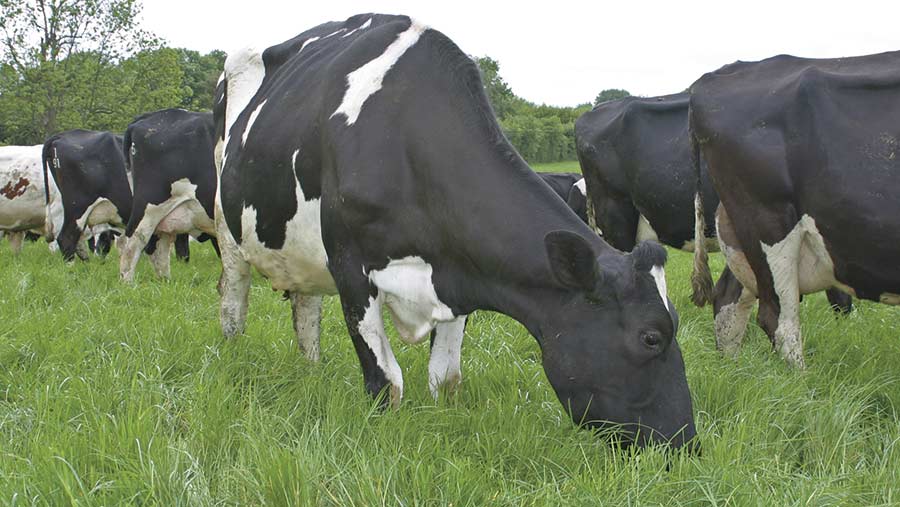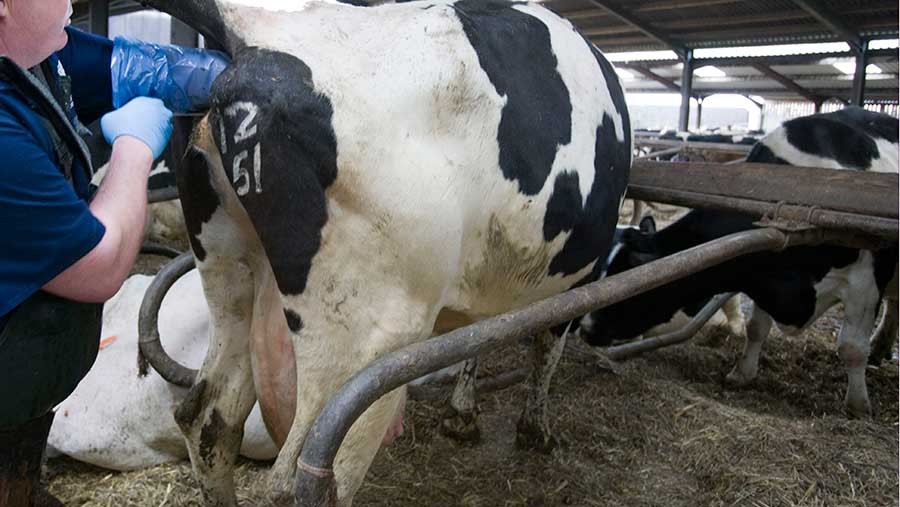3 steps to get spring-calving cows back in calf quickly

It is essential for the profitability of a spring-calving dairy herd to ensure a tight block with as many cows as possible calving in the first three weeks, as every day later reduces milk production during that lactation.
Achieving this is a result of good planning and early interventions to ensure cows are cycling and ready to conceive come the planned start of mating.
Phil Elkins, vet at Westpoint Vets gives us his advice.
There are three major areas to consider for a spring-calving herd.
 Phil Elkins is a vet at Westpoint Vets, St Columb, Cornwall
Phil Elkins is a vet at Westpoint Vets, St Columb, Cornwall1. Nutrition
The oocyte (egg) that is ovulated when a cow comes bulling has been developing during the previous 60 days.
This means the quality of the egg is directly linked to the nutritional status of the cow in the two months before the planned mating period.
This then dictates the likelihood of conception, implantation and maintenance of pregnancy.
See also: Prepare now for spring calving
Therefore, from a month after the start of the calving block, the cows need to be in positive energy balance and maintain it throughout the breeding period.
To achieve this, producers need to drive dry matter intakes and ensure quality of forage.
High dry matter intakes throughout this period can be achieved through good rumen fill before calving and continuous feed availability after calving.
This means grazing may need to be supplemented with additional forage sources if grass growth in the early season is less than expected or overwintered covers are less than required.
The same principle is also true of energy requirements – when weather is bad and grass energy levels or dry matters are substandard, supplementary feed may be required.
Fat mobilisation (loss of body condition) because of nutritional issues in the period between calving and service can be disastrous for conception.
2. Fertility plan
Having a sound fertility plan formulated with your vet will help achieve your fertility goals.
There are a number of principles that should be considered for all blocks, and will form a good starting point for a fertility plan.
For successful fertility, cows must be cycling as soon after calving as possible.
This requires efficient heat detection before the start of the breeding season to ensure any animals that are not cycling are identified and treated.
When writing a fertility plan for a spring block-calving herd, it is best to work backwards. Ask when you want the cows to start calving – this will determine when you want to start them mating.

© FLPA / John Eveson/REX/Shutterstock
Planned start of calving (PSC) should be determined by likely forage availability together with the likely ability to access the grazing platform – there will be considerable geographic variation in this.
The planned start of mating (PSM) date is 283 days before PSC.
Once this has been determined, a non-cycler visit can be set to allow appropriate veterinary treatment of those cows not demonstrating natural heats before the breeding season.
The date of this visit should be set to ensure cows are served in the first few days of the mating season.
For example, if an Ovsynch programme (with or without progesterone implant) is used, the non-cycler visit should be 10 days before PSM.
To determine which cows require a non-cycler visit, it is essential to start heat detection at least 24 days before the non-cycler visit. Commonly used aids include tail paint/chalk or KamaRs.
This allows a second colour of tail paint to be applied, or the absence of KamaR (which gets removed once set off) to indicate those cows that have bulled.
To maximise conception rates, it is essential to minimise the effect of post-calving infection.
This is linked to good control of dystocia through body condition management and sound sire selection, together with control of calcium and trace element status.
Some level of endometritis is, however, inevitable. Early detection and appropriate treatment will reduce the effects on fertility outcomes.
At the same time as starting heat detection, all cows that are at least 21 days calved should be checked for endometritis and treated appropriately if present. These can then be followed up at the non-cycler visit.
3. Service plan
Once you have prepared the cows appropriately for the breeding season, the rest is down to identification of cows in heat (using aids if appropriate) and successful artificial insemination.

© FLPA/REX/Shutterstock
When sufficient replacements are likely to have been conceived from dairy semen via AI, bulls are often used to serve the remaining cows.
To maximise the success of insemination, annual AI refresher courses should be undertaken, and any bulls should undergo a bull breeding soundness examination before they are used.
The importance of these assessments cannot be stressed enough within the scope of this article.
Successful fertility in any herd is the result of careful planning. The situation in spring block-calving herds is no different and working together with your vet can lead to a tight calving block and a successful enterprise.
